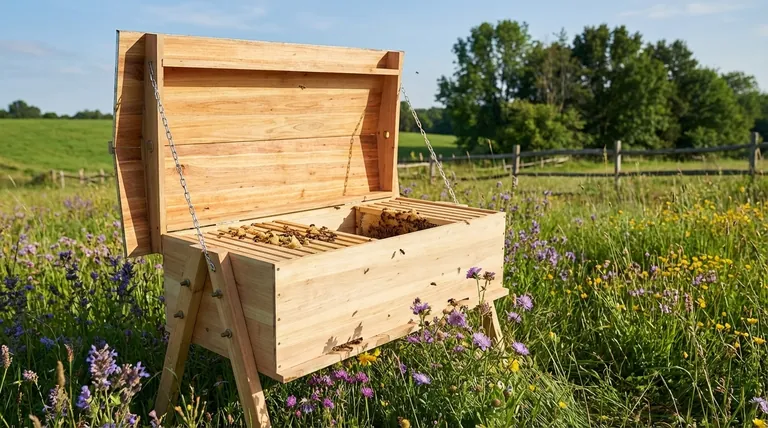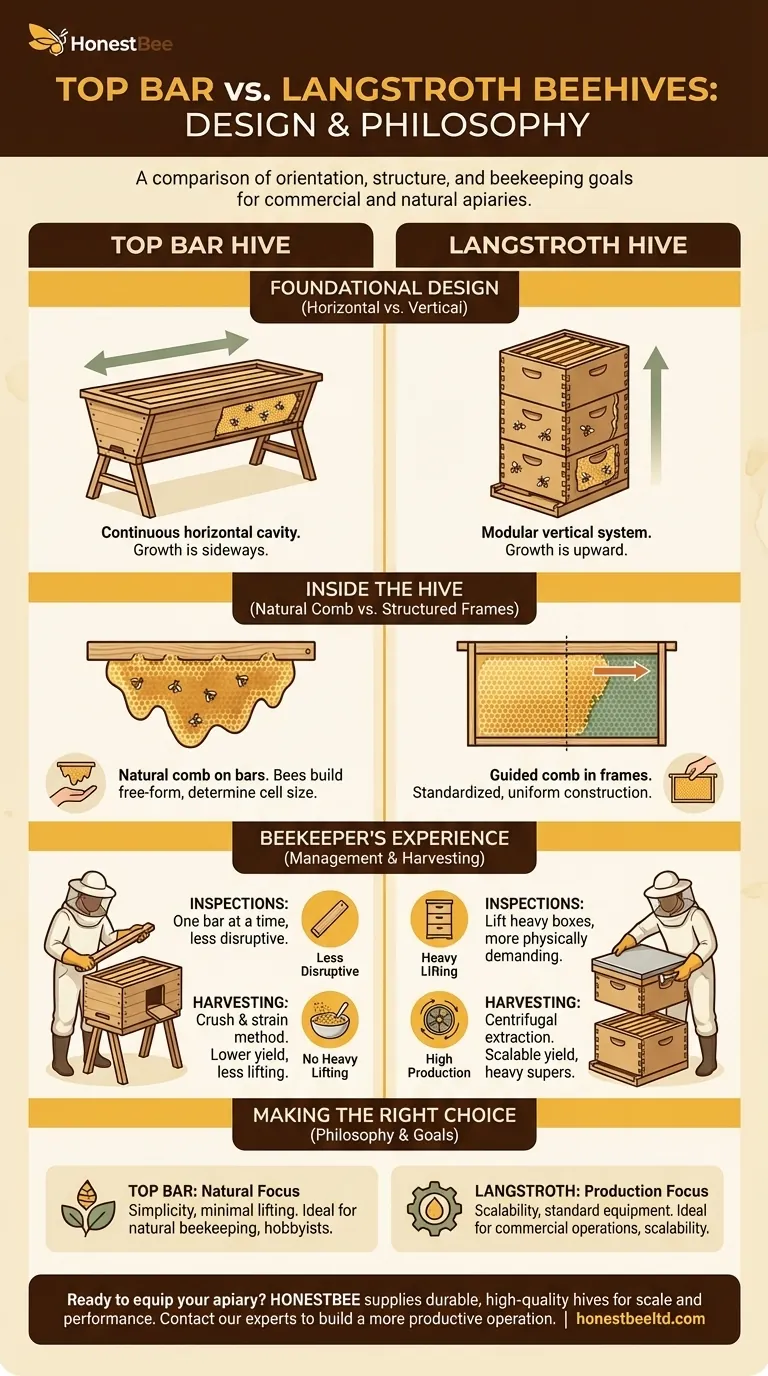The primary design difference is orientation and internal structure. A Top Bar Beehive is a single, long horizontal box where bees build their own comb hanging from simple wooden bars. In contrast, the Langstroth Beehive is a system of vertical, stackable boxes containing removable frames that guide comb construction.
The choice between these two hive designs is not about which is superior, but which philosophy aligns with your beekeeping goals. The Top Bar favors simplicity and a less intrusive approach, while the Langstroth is built for standardization and scalable honey production.

Foundational Design: Horizontal vs. Vertical
The most significant distinction lies in how the hives are shaped and how they expand. This core difference influences nearly every aspect of hive management.
The Top Bar Hive: A Continuous Horizontal Cavity
A Top Bar hive consists of a single, long trough-like box. The bees work their way horizontally across the length of the hive.
The queen establishes her brood nest at one end. As the colony grows and needs more space for honey, they simply build new comb on the adjacent empty bars, moving progressively toward the other end.
The Langstroth Hive: A Modular Vertical System
The Langstroth hive is the most recognizable design, composed of vertically stacked boxes, often called "supers" or "hive bodies."
Expansion is managed by adding more boxes on top. The brood nest is typically in the bottom boxes, and honey is stored in the upper boxes, mimicking how bees naturally store resources above their young.
Inside the Hive: Natural Comb vs. Structured Frames
How bees build their home inside each hive reflects a key philosophical difference between the two systems.
Natural Comb on Bars
In a Top Bar hive, the beekeeper provides only simple wooden bars. The bees draw out their own comb from scratch, hanging it from the underside of each bar in a natural, free-form shape.
This method is often preferred by those practicing a more "natural" style of beekeeping, as it allows the bees to determine their own cell sizes and comb structure.
Guided Comb in Frames
The Langstroth hive uses rectangular frames that precisely fit within each box. These frames often hold a sheet of "foundation" (wax or plastic) which guides the bees to build straight, uniform combs.
This standardization is a key advantage of the Langstroth. It makes comb easy to inspect and allows for mechanized honey extraction without destroying the comb.
The Beekeeper's Experience: Management and Harvesting
Your day-to-day interaction with the bees is profoundly different depending on the hive design.
Inspecting a Top Bar Hive
Inspections are done one bar at a time. The beekeeper only needs to open a small portion of the hive to remove and examine a single comb, which is less disruptive to the colony as a whole.
Managing a Langstroth Hive
A full Langstroth inspection often requires "breaking" the hive apart—lifting off heavy boxes that can weigh over 50 pounds to access the brood nest below. This can be more disruptive and physically demanding.
Harvesting Honey
In a Top Bar hive, honey is harvested by removing a few bars of honeycomb, cutting the comb off the bar, and then crushing it to release the honey. This process does not require heavy lifting.
Langstroth honey harvesting involves removing entire heavy supers filled with frames. These frames are then typically put into a centrifugal extractor to spin the honey out, preserving the comb for the bees to refill.
Understanding the Trade-offs
Neither system is perfect. Choosing one requires understanding its inherent compromises.
Top Bar: Simplicity for Less Standardization
The greatest advantage of the Top Bar hive is its simplicity and lack of heavy lifting. However, the non-standard, fragile comb cannot be put in a honey extractor and generally yields less honey per harvest.
Langstroth: Production for More Physical Effort
The Langstroth is the industry standard for a reason. Its modular and standardized design maximizes honey production and allows for interchangeable parts. This efficiency, however, comes at the cost of lifting extremely heavy boxes.
Making the Right Choice for Your Goal
Your personal beekeeping philosophy, physical abilities, and primary objectives should guide your decision.
- If your primary focus is natural beekeeping and minimal heavy lifting: The Top Bar hive's single-box design and one-comb-at-a-time management is the ideal choice.
- If your primary focus is maximizing honey production and using standard equipment: The Langstroth hive is the undisputed industry standard for its scalability and efficiency.
Ultimately, the best beehive is the one that allows you to be a successful and attentive steward of your bees.
Summary Table:
| Feature | Top Bar Hive | Langstroth Hive |
|---|---|---|
| Orientation | Horizontal, single box | Vertical, stackable boxes |
| Comb Building | Natural, built by bees on bars | Guided, built on standardized frames |
| Honey Harvesting | Cut-comb method; no heavy lifting | Centrifugal extraction; involves heavy supers |
| Primary Advantage | Simplicity, minimal intrusion | Scalability, high honey production |
| Best For | Natural beekeeping, hobbyists | Commercial production, standardized operations |
Ready to equip your apiary with the right hive system?
Whether you manage a commercial operation or supply equipment to distributors, choosing the correct hive design is critical for efficiency and honey yield. HONESTBEE supplies durable, high-quality Top Bar and Langstroth beehives and components tailored for scale and performance.
Let us help you build a more productive and manageable beekeeping operation. Contact our experts today to discuss your specific needs and explore our wholesale-focused catalog of beekeeping supplies and equipment.
Visual Guide

Related Products
- Long Langstroth Style Horizontal Top Bar Hive for Wholesale
- Top Bar Beehive for Beekeeping Wholesales Kenya Top Bar Hive
- HONESTBEE Professional Long Handled Hive Tool with Precision Cutting Blade
- HONESTBEE Professional Multi-Functional Hive Tool with Ergonomic Wood Handle
- HONESTBEE Advanced Ergonomic Stainless Steel Hive Tool for Beekeeping
People Also Ask
- What are the advantages of a top bar hive? Simpler, Bee-Centric Beekeeping for All
- How are entrances designed in top bar hives? Master Beehive Layout for Maximum Honey
- What are the box management requirements for a top bar hive vs. Langstroth? Choose Your Hive Strategy
- What are the main differences between Langstroth hives and top bar hives? Choose the Right Hive for Your Beekeeping Goals
- How does the design of a top bar hive benefit beekeepers? Ergonomic & Natural Beekeeping for Hobbyists



















